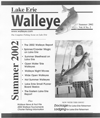|
Walleyes Down Under
By Ron Anlauf
Idle time spent in a boat gets one thinking, like: Why arenít the fish
biting and where have they gone? From there you start to imagine where they
might be hanging out and what it might look like down there. Getting a
birdís eye view from the fishís perspective would be great but it wasnít a
real
 possibility
heretofore, that is unless you had the time, and the scuba gear, and the
lessons, to get the job done. In that case you had to be really serious and
committed, as you would be spending a lot more time investigating and a lot
less time angling. The trade off could be well worth the effort it in the
long run, but it wasnít always practical. possibility
heretofore, that is unless you had the time, and the scuba gear, and the
lessons, to get the job done. In that case you had to be really serious and
committed, as you would be spending a lot more time investigating and a lot
less time angling. The trade off could be well worth the effort it in the
long run, but it wasnít always practical.
All that has changed with the introduction of the underwater camera and
has opened up a whole new underwater world. The camera can get you in and
out quick, and will allow you to wet a line and investigate all at the same
time. Even though that combination is possible there is a good chance that
watching a live camera will keep you mesmerized and some of your angling
efforts will shift to pure research.
Improvements in electronic depth finders have helped unlock some of the
secrets to locating fish and structure, but have come up a little short when
it comes to absolute information, leaving the user with plenty of unanswered
questions. For example, the best graph in the world canít identify the
species of a fish, and it canít reveal the whereabouts of fish clinging
tight to a rugged bottom.
For example: Mille Lacs Lake in Central Minnesota is well known for itís
tremendous walleye angling and deservedly so, but walleyes arenít the only
fish swimming in itís rich waters. Nice big arcs marked on a graph doesnít
necessarily mean walleyes, even if they show up in the right place at the
right time of the year. To give you an idea, an early season run to a deep
rocky hump indicated a screen full of walleyes.
After a good deal of time spent and wasted trying to get the first fish
to take a bait it became apparent that they just werenít interested. A quick
scan of the area with the underwater camera produced the answer to the lack
of interest exhibited by all those arcs; They werenít walleyes, they were
big suckers. There is no doubt that the same scenario is repeated over and
over again by anglers limited to relying solely on their depth finders to
locate and identify fish.
Thinking that you know what youíre electronics is telling you can waste
valuable fishing time, specially when what you think you know keeps you in
unproductive areas. Another case in point involved a sandy area that
occasionally produces good early season catches, and the depth finder was
indicating marks holding belly to the bottom, and which should be catchable.
After a good amount of time spent experimenting with different baits and
techniques with no success, down went the camera only to reveal that the
fishy looking marks were actually short growing clumps of weeds, with
absolutely no walleyes in sight.
fishing time, specially when what you think you know keeps you in
unproductive areas. Another case in point involved a sandy area that
occasionally produces good early season catches, and the depth finder was
indicating marks holding belly to the bottom, and which should be catchable.
After a good amount of time spent experimenting with different baits and
techniques with no success, down went the camera only to reveal that the
fishy looking marks were actually short growing clumps of weeds, with
absolutely no walleyes in sight.
Besides keeping you from wasting time in fishless waters, the camera can
also help you to stay put, even when you think thereís nobody home. For
example: A recent trip involved a little early season angling on a lake that
is known for producing numbers of nice sized walleyes, but the only thing
taking the bait was a
bunch of hammer handle sized northern pike. Sure the pike were fun to
catch but they really werenít what we were after. The lack of success would
have led one to believe that they simply werenít there, but nothing could
have been further from the truth. In fact not only did the good spots hold
numbers of walleyes, but the marginal spots were holding plenty of fish as
well. A quick scan with the camera of an area known for being an early
season hot spot revealed all kinds of walleyes, itís just that they werenít
interested at the time. Knowing all those fish were there brought us back
later in the evening, where we found the walleyes in a much better mood and
where we were able to quickly put together a respectable catch. Without the
camera we probably would have hit the road for home prematurely and missed
out on the best bite of the day.
An underwater camera should be easy to set up or it probably won't get
used and is where the OVS from Marcum Technologies really comes in handy.
The whole thing comes in a compact carrying case that is completely set up
and ready to go. It also has a built in telescoping sun shade that helps
make daytime viewing a breeze. The bottom line is that because the unit is
more easily read and used it will get more use, and because it gets more use
youíll learn more and have more fun.
The OVS has proven to be a big hit with kids, as they are attracted to it
like they would be to a new video game. Itís a great teaching tool that will
help to grab their attention and keep them interested, even when the fish
are being less than cooperative. Slow fishing action translates into boredom
for beginning anglers, and boredom may keep them from becoming full fledged
participants in a sport that needs new entries.
|





 possibility
heretofore, that is unless you had the time, and the scuba gear, and the
lessons, to get the job done. In that case you had to be really serious and
committed, as you would be spending a lot more time investigating and a lot
less time angling. The trade off could be well worth the effort it in the
long run, but it wasnít always practical.
possibility
heretofore, that is unless you had the time, and the scuba gear, and the
lessons, to get the job done. In that case you had to be really serious and
committed, as you would be spending a lot more time investigating and a lot
less time angling. The trade off could be well worth the effort it in the
long run, but it wasnít always practical.  fishing time, specially when what you think you know keeps you in
unproductive areas. Another case in point involved a sandy area that
occasionally produces good early season catches, and the depth finder was
indicating marks holding belly to the bottom, and which should be catchable.
After a good amount of time spent experimenting with different baits and
techniques with no success, down went the camera only to reveal that the
fishy looking marks were actually short growing clumps of weeds, with
absolutely no walleyes in sight.
fishing time, specially when what you think you know keeps you in
unproductive areas. Another case in point involved a sandy area that
occasionally produces good early season catches, and the depth finder was
indicating marks holding belly to the bottom, and which should be catchable.
After a good amount of time spent experimenting with different baits and
techniques with no success, down went the camera only to reveal that the
fishy looking marks were actually short growing clumps of weeds, with
absolutely no walleyes in sight.